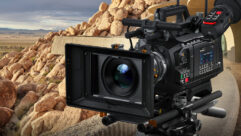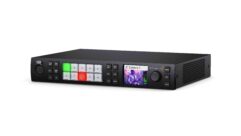LET’S GET REAL
Jan 1, 2003 12:00 PM,
PETER H. PUTMAN, CTS
In the past year, I had the opportunity to participate in a Projection Industry Summit Conference, coordinated by Insight Media and McLaughlin Consulting. Among the many seminars and panel discussions was a presentation by several industry analysts, including Bill Coggshall of Pacific Media Associates, Tony Bicknell of Decision Tree Consulting, Midori Takaso of Techno Systems Research, and me.
The marketing panel attempted to peer into the future and forecast the growth markets for projection technology. Given the number of manufacturers peddling LCD, DLP, and LCoS projectors, it’s no wonder they are all looking past traditional pro A/V and IT distribution channels for new fields to harvest.
According to moderator Chuck McLaughlin, 80 percent of the 1.4 million projectors sold in 2001 were used for “enterprise presentations” — that is, in corporations, government offices, and institutions. His questions were these: are these markets saturated, and are there other opportunities for growth? Two possibilities came up. The first was education, a potentially huge market that has been constrained by the price of projectors and tight budgets. The other was home theater, one of the few bright spots of this past year’s economy.
According to McLaughlin’s numbers, the education market is underserved, with about 10 to 20 percent of 2001 purchases going into primary and secondary classrooms. Price is very much an issue, and savvy product marketing managers know that keeping lower-priced SVGA (800-by-600) models in their line is a good business decision, because they are popular with educators. It’s a rather oddball market example. SVGA projectors are still overwhelmingly preferred for this market, even when the newest XGA projectors cost the same as last year’s SVGA models. It appears the only way educators will move from SVGA to XGA is to enact further price cuts and drop support for SVGA resolution entirely.
DEVIL’S ADVOCATE
Home theater also looks promising, accounting for about 5 to 10 percent of all front-projector sales in 2001. There’s even more potential in rear-projection TVs to move away from CRTs to fixed-pixel imaging, though CRTs are still expected to have the lion’s share of this market for the next few years. Cast in the role of devil’s advocate, I pointed out that there will be plenty of competition in the home-theater space — and to a lesser degree, the education market — from flat-screen TVs and monitors. That made me a popular fellow with the projector aficionados.
Several months later, I’m seeing many signs that plasma and LCD monitors and TVs are up to the challenge. Prices have dropped at a breathtaking rate, even faster than I had predicted. LCDs are being manufactured in 40-inch 16-by-9 sizes, and 42-inch and even 46-inch panels will come to market in 2003.
An eCost.com “hot sheet” catalog showed that Sony’s PFM32C1, 32-inch plasma retails for $4,799 (plus shipping and handling); Hitachi’s CMP4142HDE 42-inch ALiS panel for $3,999; Panasonic’s TH42PWD5U 1,024-by-768, 42-inch panel for $3,849; and Sony’s silver or gray PFM-42B2 ALiS panel for $4,999. Even Pioneer’s PDP-433CMX sells for $5,000, and that includes the PD-5002 component/DVI video card. The same panel is sold as the PRO800HD into the home-theater market for almost $4,000 more. NEC’s discontinued PS50MP2, 50-inch plasma (1,365-by-768) can be had for $9,000, and Panasonic’s TH-50PHD3U 50-inch glass is $8,000.
PRICES AND OPPORTUNITIES
In the meantime, projector prices continue to plummet with three major sub-$2,000 model announcements in the past two months from InFocus, Epson, and Toshiba. All are SVGA bare-bones designs that will have strong appeal to the education and nonprofit market segments. Street prices could soon be under $1,000 for more than one model.
The eCost.com hot sheet also shows the Hitachi CP-S225W for just $1,499. That is another member of the 800-by-600 LCD family targeted at educators. It has about 800 to 1,000 lumens brightness and a minimal amount of operating features, but it does have a short-throw lens for close-up projection of large images and also scales 1,024-by-768 sources down to SVGA.
Given that the education market is all about large group presentations under a variety of ambient light conditions, this is where the biggest opportunity lies for projector manufacturers. A small bright model that is easy to set up and operate yet can be locked away safely will appeal to many primary- and secondary-school teachers. Such projectors will take the place of older filmstrip, slide, and movie projectors in classrooms. Technology add-ons like 802.11b wireless will be useful to this group, as will memory PC Cards, off-axis image correction, and automatic presentation sequencing to eliminate the need for an external PC.
Far more of the portable do-it-all projectors will be sold than desktop and installation projectors, the bread and butter of the pro A/V systems integration channel. That’s because classrooms are put to many uses, and A/V equipment moves around — not the student.
But the home-theater market is a different story. Probably less than 10 percent of home theaters use — or will use — some sort of front-projection system. Many new homes are being built with media rooms, but the vast majority of TV viewing is done under normal ambient lighting — not with a screen pulled down and the lights dimmed.
Many of those new homes have big windows and atriums that let in lots of light. That’s not a favorable environment for front projectors, but direct-view and rear-projection TVs will do just fine. The move to pure flat screens has also resulted in some really clever product designs (look at Sharp’s Aquos TV line) that have far more appeal to the eye than big, bulky tube-equipped RPTVs.
Another factor to consider is that consumers have watched self-contained video displays since broadcast TV became available in the ’40s. It’s a pretty good solution, with screen, tuner, and audio amp all in one box. Just turn on the power, change channels, and go.
So it stands to reason that the easiest way to sell a home-theater video display to customers is to show them a snazzier, cooler-looking version of what they have now. That’s exactly what the manufacturers of plasma and AM-LCD TVs are counting on, which is why there are forecasts of more than 4 million plasma TVs sold into the home by 2006.
LCD prices, while higher than plasma in the same size, are also plummeting rapidly. Sharp’s 28-inch wide-screen LCD monitor retailed for nearly $14,000 in early 2001. Its successor, a 30-inch wide-screen LCD TV, now lists for $7,000. Samsung’s new 40-inch wide-screen LCD monitor has an MSRP (as of CEDIA Expo 2002) of less than $10,000, and that will drop quickly to a more market-favorable level in 2003.
One of my local home-theater dealers remodeled his projector showroom to feature two plasma displays and some RPTVs. A salesperson said that they didn’t sell enough projectors to tie up the room, and the RPTVs and flat-screen LCD/plasma sets were all the rage.
FLAT SCREENS
Every manufacturer of home-theater products has expanded its line of flat-screen offerings for 2003. Mitsubishi has several plasma monitors and two new LCDs. Runco has a new 22-inch LCD TV. Zenith’s trade-show booths are dominated by plasma and LCD (as well as LCD-equipped RPTVs), and Samsung’s booths are also loaded up with LCDs, plasma, and several DLP-engined RPTVs.
Marantz, Toshiba, Sony, Pioneer, Fujitsu, Sharp, and others are supporting several models of flat-screen plasma and LCD monitors. It’s clear to them that the mainstream market wants to stay with self-contained TVs. Although a few of those companies also sell projection systems, it’s a safe bet that RPTVs and direct-view designs will be a growing segment of their revenues in the near future.
Projectors are marvelous things, and they can do many jobs well. But to expect the same level of sales growth in the next two to three years as in the past seven years is fantasy. Dropping the price of projectors may stimulate more sales, but it will also convince many dealers to drop the low-priced models from their lines.
Flat-screen dealers shouldn’t get too cocky, either. A glut of product and Japan’s sluggish economy are driving price wars, just like those seen with projectors. A 50-inch plasma monitor had an MSRP of close to $20,000 in 1999, and now they’re selling for 27 percent less. We haven’t hit bottom yet.
Peter H. Putman owns PHP Communications, in Doylestown, Pennsylvania. The author of The Toastmasters Guide to Audio/Visual Presentations, Putman is also a regular columnist in S&VC.










